Related Research Articles
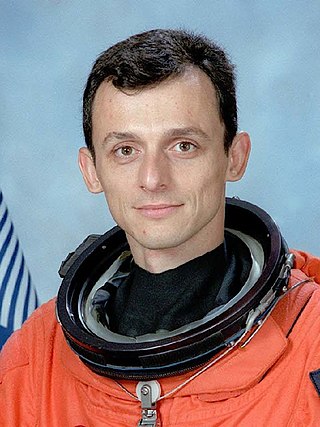
Pedro Francisco Duque Duque, OF, OMSE is a Spanish astronaut and aeronautics engineer who served as minister of Science from 2018 to 2021 and member of the Congress of Deputies, representing Alicante, from May 2019 until February 2020.

Edward Michael "Mike" Fincke is an American astronaut who formerly held the American record for the most time in space. His record was broken by Scott Kelly on October 16, 2015.
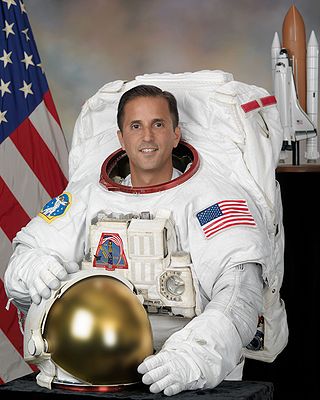
Joseph Michael Acabá is an American educator, hydrogeologist, and NASA astronaut. In May 2004, he became the first person of Puerto Rican ancestry to be named as a NASA astronaut candidate, when he was selected as a member of NASA Astronaut Training Group 19. He completed his training on February 10, 2006, and was assigned to STS-119, which flew from March 15 to 28, 2009, to deliver the final set of solar arrays to the International Space Station. He is the first person of Puerto Rican origin, and the twelfth of fifteen people of Ibero-american heritage to have flown to space.
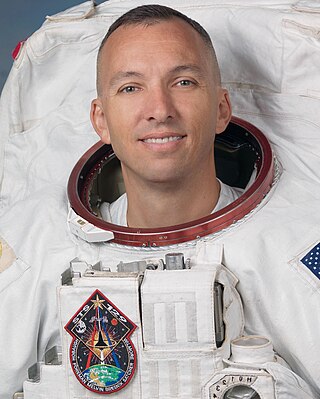
Randolph James "Komrade" Bresnik is a retired officer in the United States Marine Corps and an active NASA astronaut. A Marine Aviator by trade, Bresnik was selected as a member of NASA Astronaut Group 19 in May 2004. He first launched to space on STS-129, then served as flight engineer for Expedition 52, and as ISS commander for Expedition 53.

Sergey Nikolayevich Ryzhikov, lieutenant colonel of Russian Air Force, is a Russian cosmonaut, selected in 2006. He is a veteran of two long duration space flights to the ISS.

Aleksey Nikolayevich Ovchinin is a Russian Air Force Major and cosmonaut, who was selected in 2006. Ovchinin made his first spaceflight in 2016, and was assigned as commander of Soyuz MS-10 in 2018.

Richard Robert "Ricky" Arnold II is an American educator and a NASA astronaut. He flew on Space Shuttle mission STS-119, which launched March 15, 2009, and delivered the final set of solar arrays to the International Space Station. He launched again in 2018 to the ISS, onboard Soyuz MS-08.

Takuya Onishi is a Japanese astronaut who was selected for the Japan Aerospace Exploration Agency (JAXA) in 2009. He spent four months on board the International Space Station in 2016.
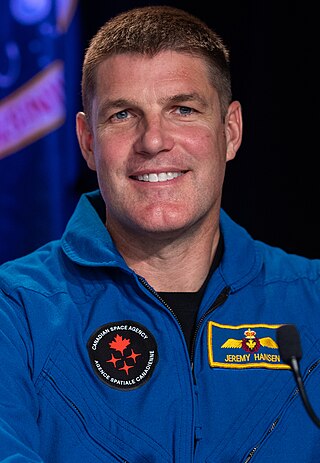
Jeremy Roger Hansen is a Canadian astronaut, fighter pilot, physicist and former aquanaut. He was selected to join the Canadian Space Agency in the 2009 CSA selection along with David Saint-Jacques. Prior to his selection as one of Canada's astronauts, Hansen was a Royal Canadian Air Force captain, piloting the CF-18 fighter jet at CFB Cold Lake, Alberta. He has since been promoted to the rank of colonel.

Thomas Gautier Pesquet is a French aerospace engineer, pilot, European Space Agency astronaut, actor and writer. Pesquet was selected by ESA as a candidate in May 2009, and he successfully completed his basic training in November 2010. From November 2016 to June 2017, Pesquet was part of Expedition 50 and Expedition 51 as a flight engineer. Pesquet returned to space in April 2021 on board the SpaceX Crew Dragon for a second six-month stay on the ISS.

Andreas Enevold "Andy" Mogensen is a Danish engineer and ESA astronaut who is best known for being the first Dane to fly in space as part of the European Space Agency's Iriss program. Mogensen has also been involved in a number of other space-related projects throughout his career, including working as a test engineer for ESTEC and as a member of the European Astronaut Corps. In addition to his work with ESA, he has also worked with NASA and other international space agencies. Mogensen returned to space in August 2023 for his second spaceflight to the ISS onboard SpaceX Crew Dragon as the first non-American to serve as a pilot.

Colonel Luca Parmitano is an Italian astronaut in the European Astronaut Corps for the European Space Agency (ESA). He was selected as an ESA astronaut in May 2009. Parmitano is also a Colonel and test pilot for the Italian Air Force. He is the first Italian to command the International Space Station (ISS) during Expedition 61.

Alexander Gerst is a German European Space Agency astronaut and geophysicist, who was selected in 2009 to take part in space training. He was part of the International Space Station Expedition 40 and 41 from May to November 2014. Gerst returned to space on 6 June 2018, as part of Expedition 56/57. He was the Commander of the International Space Station. He returned to Earth on 20 December 2018. After the end of his second mission and before being surpassed by Luca Parmitano in 2020, he held the record for most time in space of any active ESA astronaut, succeeding Italian astronaut Paolo Nespoli, and German ESA astronaut Thomas Reiter, who formally held the record for the longest time in space for any active or retired ESA astronaut.

Jeanette Jo Epps is an American aerospace engineer and NASA astronaut. Epps received both her M. S. and Ph.D. degrees in aerospace engineering from the University of Maryland, where she was part of the rotor-craft research group and was a NASA GSRP Fellow. She was chosen for the 20th class of NASA astronauts in 2009, graduating in 2011. Epps currently serves as a member of the ISS Operations Branch and has completed analog astronaut missions, including NEEMO 18 and CAVES 19. She is the second woman and first African-American woman to have participated in CAVES. She is currently in space for a long duration mission on the ISS, after launch in 4 March 2024, as part of the SpaceX Crew-8 crew.

Jack David Fischer is an American engineer, test pilot and a former NASA astronaut. Fischer was selected in June 2009 as a member of the NASA Astronaut Group 20 and qualified as an astronaut in 2011. He made his first spaceflight in April 2017, as a flight engineer for Expedition 51/52 on the International Space Station.

CAVES, an acronym for Cooperative Adventure for Valuing and Exercising human behaviour and performance Skills, is a European Space Agency astronaut training course in which international astronauts train in a space-analogue cave environment. Designed at the European Astronaut Center, the course aims to prepare astronauts for safe and efficient long duration spaceflight operations by means of a realistic scientific and exploration mission within a multicultural, ISS-representative team.

Joshua Kutryk is a Canadian astronaut, fighter pilot and engineer. He was selected by the Canadian Space Agency (CSA) one of the two members of the 2017 CSA Group alongside Jenni Sidey.

Sergey Vladimirovich Kud-Sverchkov is a Russian cosmonaut, selected in 2010 by Roscosmos. He made his first spaceflight in 2020 aboard the International Space Station as a flight engineer for ISS Expedition 63/64.

Nikolay Aleksandrovich Chub is a cosmonaut selected by the Roscosmos space agency in 2012.
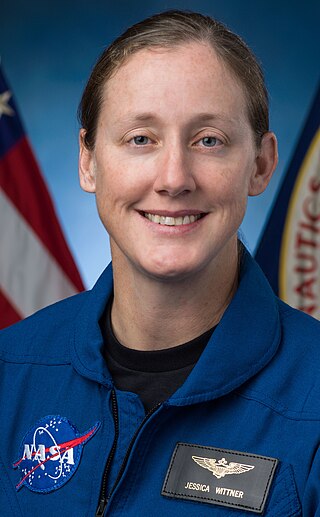
Jessica Wittner is a lieutenant commander in the United States Navy and NASA astronaut candidate.
References
- ↑ Francesco Sauro, Samuel J. Payler, Matteo Massironi, Riccardo Pozzobon, Harald Hiesinger, Nicolas Mangold, Charles S. Cockell, Jesus Martínez Frias, Kåre Kullerud, Leonardo Turchi, Igor Drozdovskiy, Loredana Bessone, Training astronauts for scientific exploration on planetary surfaces: The ESA PANGAEA programme, Acta Astronautica, Volume 204, 2023, Pages 222-238, ISSN 0094-5765, https://doi.org/10.1016/j.actaastro.2022.12.034.
- ↑ "What is Pangaea?". www.esa.int.
- ↑ Williams, Matt (September 14, 2016). "Get That Geologist A Flight Suit!".
- ↑ Agency, European Space. "Training astronauts to be scientists on the moon". phys.org.
- ↑ https://www.esa.int/Science_Exploration/Human_and_Robotic_Exploration/CAVES_and_Pangaea/What_is_CAVES, What is CAVES
- ↑ Sauro, F., Massironi, M., Pozzobon, R., Hiesinger, H., Mangold, N., Frias, J.M., Cockell, C. and Bessone, L., 2018b. Training astronauts for field geology: The ESA PANGAEA Training and PANGAEA-extension testing analogue. LPI, (2083), p.1120.
- ↑ Buz, J., Ehlmann, B.L., Pan, L. and Grotzinger, J.P., 2017. Mineralogy and stratigraphy of the Gale crater rim, wall, and floor units. Journal of Geophysical Research: Planets, 122(5), pp.1090-1118.
- ↑ Pösges, G., 2005. The Ries Crater Museum in Nördlinger, Bavaria, Germany. Meteoritics & Planetary Science Archives, 40(9-10), pp.1555-1557.
- ↑ Sauro, F., Massironi, M., Pozzobon, R., Hiesinger, H., Mangold, N., Cockell C.S., Frias, J.M., Payler, S.J. and Bessone, L., 2020a. Geological and astrobiological training to prepare astronauts for planetary surface exploration. LPSC 2020 (1963).
- ↑ Miller, A.Z., Gonzalez-Pimentel, J.L., Maurer, M., Stahl, S., Castro-Wallace, S., Bessone, L., Martinez-Frias, J. and Sauro, F., 2020. Geomicrobiological Field Research in a Subsurface Analogue Environment for Future Planetary Caves Missions. 3rd International Planetary Caves Conference LPICo, 2197, p.1052.
- ↑ Turchi, L., Payler, S.J., Sauro, F., Pozzobon, R., Massironi, M. and Bessone, L., 2021. The Electronic FieldBook: A system for supporting distributed field science operations during astronaut training and human planetary exploration. Planetary and Space Science, 197, p.105164.
- ↑ Jahoda, P., Drozdovskiy, I., Payler, S.J., Turchi, L., Bessone, L. and Sauro, F., 2021. Machine learning for recognizing minerals from multispectral data. Analyst, 146(1), pp.184-195.
- 1 2 Drozdovskiy, I., Ligeza, G., Jahoda, P., Franke, M., Lennert, P., Vodnik, P., Payler, S.J., Kaliwoda, M., Pozzobon, R., Massironi, M. and Turchi, L., 2020a. The PANGAEA mineralogical database. Data in brief, 31, p.105985.
- ↑ published, Samantha Mathewson (2023-10-26). "Astronauts test moon camera design for future Artemis missions". Space.com. Retrieved 2024-05-24.
- ↑ Chacko, Amal Jos. "NASA and ESA combine to develop the best camera for its Artemis mission". Interesting Engineering. Retrieved 2024-05-24.
- ↑ "Next generation Moon camera tested in Europe". www.esa.int. Retrieved 2024-05-24.
- ↑ Bessone, L., Sauro, F., Maurer, M. and Piens, M., 2018b. Testing technologies and operational concepts for field geology exploration of the Moon and beyond: the ESA PANGAEA-X campaign. EGUGA, p.4013.
- 1 2 Rossi, A.P., Unnithan, V., Torrese, P., Borrmann, D., Nuechter, A., Lauterbach, H., Ortenzi, G., Jaehrig, T., Sohl, F., Pozzobon, R. and Sauro, F., 2018. AGPA: Integrating field Geology and Geophysics for Planetary Analogues. EPSC, pp.EPSC2018-408.
- ↑ Torrese, P., Rossi, A.P., Unnithan, V., Borrmann, D., Lauterbach, H., Luzzi, E., Pozzobon, R., Sauro, F., Bessone, L. and Nuechter, A., 2019, January. Imaging the subsurface of planetary volcanic analogues using ambient seismic noise data at the Tinguatón Volcano (Lanzarote, Canary Islands). In Geophysical Research Abstracts (Vol. 21).
- ↑ Luzzi, E., Massironi, M., Pozzobon, R., Payler, S., Carey, W., Sauro, F., Bessone, L., Wormnes, K., Krueger, T. and Rossi, A.P., 2020. Preparing for telerobotic geological exploration: Science Support for ESA’s Analog-1 project.
- ↑ Torrese, P., Rossi, A.P., Unnithan, V., Pozzobon, R., Borrmann, D., Lauterbach, H., Luzzi, E. and Sauro, F., 2020. HVSR passive seismic stratigraphy for the investigation of planetary volcanic analogues. Icarus, 351, p.113970.
- ↑ https://www.esa.int/Science_Exploration/Human_and_Robotic_Exploration/CAVES_and_Pangaea/Overview2, CAVES and PANGAEA overview
- ↑ Potter, Sean (December 9, 2020). "NASA Names Artemis Team of Astronauts Eligible for Early Moon Missions". NASA.
- ↑ "Train me to the Moon and back". www.esa.int. Retrieved 2023-07-21.